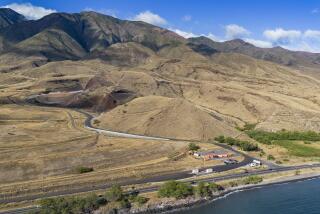Covering Up Toxic Ash Called Solution for Chollas Lake Site
- Share via
An engineering firm has estimated that it would cost the city $13.5 million to remove polluted toxic ash from a proposed Navy housing site near Chollas Lake and has instead recommended that the lead-tainted ash be covered over.
The $13.5 million would pay for removal of about 45,000 cubic yards of incinerator ash and ash-soil mixture discovered on about half of a 90-acre canyon area owned by the city, according to a report done for the Navy by Woodward-Clyde Consultants.
The city is waiting for a report from another consulting firm studying the other half of the site, which is supposed to be developed into a city park. The price tag for cleaning up that half, where toxic ash has also been found, could push the total cost much higher.
The Navy was to get half the site from the city in a land swap announced 18 months ago, but began to balk last fall when a consulting report showed that levels of lead in some spots were more than twice the amount considered toxic by state regulators. The Navy planned to build housing for 300 families on the site, but so far has refused to accept the deed.
Navy Requested Further Tests
The amount of lead pollution found at the site was substantially greater than the amount found in a preliminary study done for the Navy by Woodward-Clyde last summer. That study prompted the Navy to request further tests, the results of which were contained in the report sent to the city last Friday and obtained by The Times on Tuesday.
In the new study, Woodward-Clyde found levels of lead more than four times the toxic limit of 1,000 milligrams per kilogram for solid samples and more than 12 times the limit of five milligrams per liter for solutions. Of 31 boring samples and five surface samples tested, 16 contained lead in excess of the toxic limits.
The report says something must be done about the site because taking no action “would not prevent human contact and is therefore not considered a feasible . . . alternative.”
Deputy City Manager Coleman Conrad said Tuesday that city and Navy officials will meet in about six to eight weeks, when the report by the city’s consultant is due, “to find out what makes the most sense.”
Both Navy and city officials have said that the city is expected to pay the costs of making the site suitable for construction of homes.
Cheaper Alternative
Because of the “excessive” cost of excavating the ash--which would be classified as a hazardous waste--and disposing of it in a hazardous waste facility, the report recommends the cheaper alternative of “capping.” Excavation, transportation and disposal would cost $300 per cubic yard, the report says.
Capping the ash, however, would cost a total of $265,000 to $350,000, according to the report. Under this procedure, the ash deposits would be left in their current locations, but would be isolated beneath impermeable barriers.
The barriers, which would be placed over 130,000 square feet of surface area, could be constructed of soil cement, a bentonite-soil mixture, or a synthetic material. The area would then be covered with three feet of soil to allow for landscaping. A surface drainage system would then have to be installed, the report says.
The advantages of capping, according to the report, are that it prevents human contact with the toxic material in the ash and reduces the potential leaching of the hazardous materials through contact with rainwater and landscape irrigation.
However, the capped areas could not be used for construction of housing and “would probably require designation as non-use areas,” the report says.
If the ash were excavated, the whole area could be used for housing, the report points out.
A third alternative of “chemical fixation,” under which the affected ash and soil would be excavated and mixed with bentonite or cement to immobilize the pollutants, would cost from $2.7 million to $3.6 million, the report says. The material could then be left on the site.
However, this alternative was not recommended because of its relatively high cost and the fact that the material, although left at the site, would have to be isolated from human contact.
On Feb. 26, representatives of Woodward-Clyde met with officials of the San Diego County Department of Health Services and the Regional Water Quality Control Board to discuss potential ways to make the site suitable for residential construction, the report says.
“The primary concerns of the two regulatory agencies are the isolation of the ash deposits to prevent human contact” and the “minimization” of the potential for pollutants to migrate into the ground water, the report says.
The “capping” recommendation will have to be reviewed by the regulatory agencies, the report says.
Meanwhile, city officials say the entire canyon area has been closed off at the request of the county health department. Officials have known for decades that the area once was a city burn dump containing potentially harmful ash, but did little about it until two weeks ago, following press reports of the toxic ash. The site had been a popular recreation area for children, joggers and bicyclists.
More to Read
Sign up for Essential California
The most important California stories and recommendations in your inbox every morning.
You may occasionally receive promotional content from the Los Angeles Times.










